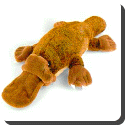 Duck-billed Platypus — The Platypus (Ornithorhynchus anatinus) is a semi-aquatic mammal endemic to eastern Australia, including Tasmania. Together with the four species of echidna, it is one of the five extant species of monotremes, the only mammals that lay eggs instead of giving birth to live young. It is the sole living representative of its family (Ornithorhynchidae) and genus (Ornithorhynchus), though a number of related species have been found in the fossil record.
Duck-billed Platypus — The Platypus (Ornithorhynchus anatinus) is a semi-aquatic mammal endemic to eastern Australia, including Tasmania. Together with the four species of echidna, it is one of the five extant species of monotremes, the only mammals that lay eggs instead of giving birth to live young. It is the sole living representative of its family (Ornithorhynchidae) and genus (Ornithorhynchus), though a number of related species have been found in the fossil record.
The bizarre appearance of this egg-laying, venomous, duck-billed, beaver-tailed, otter-footed mammal baffled European naturalists when they first encountered it, with some considering it an elaborate fraud. It is one of the few venomous mammals; the male Platypus has a spur on the hind foot that delivers a poison capable of causing severe pain to humans. The unique features of the Platypus make it an important subject in the study of evolutionary biology and a recognizable and iconic symbol of Australia; it has appeared as a mascot at national events and is featured on the reverse of the Australian 20 cent coin.
Until the early 20th century it was hunted for its fur, but it is now protected throughout its range. Although captive breeding programs have had only limited success and the Platypus is vulnerable to the effects of pollution, it is not under any immediate threat.
The body and the broad, flat tail of the Platypus are covered with dense brown fur that traps a layer of insulating air to keep the animal warm. The Platypus uses its tail for storage of fat reserves (an adaptation also found in animals such as the Tasmanian Devil and fat-tailed sheep). It has webbed feet and a large, rubbery snout; these are features that appear closer to those of a duck than to those of any known mammal. The webbing is more significant on the front feet and is folded back when walking on land. Unlike a bird’s beak (in which both the upper and lower parts of the beak separate to reveal its mouth), the snout of the Platypus is a sensory organ with the mouth on the underside. The nostrils are located on the dorsal surface of the snout while the eyes and ears are located in a groove set just back from it; this groove is closed when swimming. Platypuses have been heard to emit a low growl when disturbed and a range of other vocalisations have been reported in captive specimens.
In captivity Platypuses have survived to seventeen years of age and wild specimens have been recaptured at eleven years old. Mortality rates for adults in the wild appear to be low. Natural predators include snakes, water rats, goannas, hawks, owls and eagles. Low Platypus numbers in the northern Australia are possibly due to predation by crocodiles. The introduction of red foxes as a predator for rabbits may have had some impact on its numbers on the mainland. The Platypus is generally regarded as nocturnal and crepuscular, but individuals are also active during the day, particularly when the sky is overcast. Its habitat bridges rivers and the riparian zone for both a food supply of prey species and banks where it can dig resting and nesting burrows. It may have a range of up to 7 km (4.4 mi) with male’s home ranges overlapping with those of 3 or 4 females.
 Kids Portal For Parents India Kids Network
Kids Portal For Parents India Kids Network






